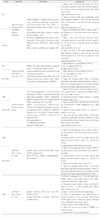1. Ernst CP, Meyer GR, Klöcker K, Willershausen B. Determination of polymerization shrinkage stress by means of a photoelastic investigation. Dent Mater. 2004. 20:313–321.

2. Weinmann W, Thalacker C, Guggenberger R. Siloranes in dental composites. Dent Mater. 2005. 21:68–74.

3. Ilie N, Jelen E, Clementino-Luedemann T, Hickel R. Low-shrinkage composite for dental application. Dent Mater J. 2007. 26:149–155.

4. Eick JD, Smith RE, Pinzino CS, Kostoryz EL. Stability of silorane dental monomers in aqueous systems. J Dent. 2006. 34:405–410.

5. Ilie N, Hickel R. Macro-, micro- and nano-mechanical investigations on silorane and methacrylate-based composites. Dent Mater. 2009. 25:810–819.

6. Mine A, De Munck J, Van Ende A, Cardoso MV, Kuboki T, Yoshida Y, Van Meerbeek B. TEM characterizatino of a silorane composite bonded to enamel/ dentin. Dent Mater. 2010. 26:524–532.
7. Van Meerbeek B, De Munck J, Yoshida Y, Inoue S, Vargas M, Vijay P, Van Landuyt K, Lambrechts P, Vanherle G. Buonocore memorial lecture. Adhesion to enamel and dentin: current status and future challenges. Oper Dent. 2003. 28:215–235.
8. Van Landuyt KL, De Munck J, Snauwaert J, Coutinho E, Poitevin A, Yoshida Y, Inoue S, Peumans M, Suzuki K, Lambrechts P, Van Meerbeek B. Monomer-solvent phase separation in one-step self-etch adhesives. J Dent Res. 2005. 84:183–188.

9. Ernst CP, Galler P, Willershausen B, Haller B. Marginal integrity of class V restorations: SEM versus dye penetration. Dent Mater. 2008. 24:319–327.

10. Duarte S Jr, Phark JH, Varjao FM, Sadan A. Nanoleakage, ultramorphological characteristics, and microtensile bond strengths of a new low-shrinkage composite to dentin after artificial aging. Dent Mater. 2009. 25:589–600.

11. Della Bona A, Anusavice KJ, Mecholsky JJ Jr. Failure analysis of resin composite bonded to ceramic. Dent Mater. 2003. 19:693–699.

12. Ito S, Hashimoto M, Wadgaonkar B, Svizero N, Carvalho RM, Yiu C, Rueggeberg FA, Foulger S, Saito T, Nishitani Y, Yoshiyama M, Tay FR, Pashley DH. Effects of resin hydrophilicity on water sorption and changes in modulus of elasticity. Biomaterials. 2005. 26:6449–6459.

13. Burrow MF, Inokoshi S, Tagami J. Water sorption of several bonding resins. Am J Dent. 1999. 12:295–298.
14. Malacarne J, Carvalho RM, de Goes MF, Svizero N, Pashley DH, Tay FR, Yiu CK, Carrilho MR. Water sorption/solubility of dental adhesive resins. Dent Mater. 2006. 22:973–980.

15. Hosaka K, Nakajima M, Takahashi M, Itoh S, Ikeda M, Tagami J, Pashley DH. Relationship between mechanical properties of one-step self-etch adhesives and water sorption. Dent Mater. 2010. 26:360–367.

16. Soles CL, Yee AF. A discussion of the molecular mechanisms of moisture transport in epoxy resins. J Polym Sci. 2000. 38:792–802.

17. Vrentas JS, Duda JL. A free-volume interpretation of the influence of the glass transition on diffusion in amorphous polymers. J Appl Polym Sci. 1978. 22:2325–2339.

18. Brazel CS, Peppas NA. Mechanisms of solute and drug transport in relaxing, swellable hydrophilic glassy polymers. Polymer. 1999. 40:3383–3398.

19. Brazel CS, Peppas NA. Dimensionless analysis of swelling of hydrophilic glassy polymers with subsequent drug release from relaxing structures. Biomaterials. 1999. 20:721–732.

20. Oysaed H, Ruyter IE. Water sorption and filler characteristics of composites for use in posterior teeth. J Dent Res. 1986. 65:1315–1318.

21. Braden M, Clarke RL. Water absorption characteristics of dental microfine composite filling materials . I. Proprietary materials. Biomaterials. 1984. 5:369–372.

22. Meşe A, Burrow MF, Tyas MJ. Sorption and solubility of luting cements in different solutions. Dent Mater J. 2008. 27:702–709.

23. Summitt JB, Robbins JW, Hilton TJ, Schwartz RS. Fundamentals of operative dentistry. 2006. 3rd ed. Hanover Park, Illinois: Quintessence Publishing Co, Inc;196.
24. Grégoire G, Dabsie F, Dieng-Sarr F, Akon B, Sharrock P. Solvent composition of one-step self-etch adhesives and dentine wettability. J Dent. 2011. 39:30–39.

25. Reis A, Leite TM, Matte K, Michels R, Amaral RC, Geraldeli S, Loguercio AD. Improving clinical retention of one-step self-etching adhesive systems with an additional hydrophobic adhesive layer. J Am Dent Assoc. 2009. 140:877–885.

26. Brackett WW, Ito S, Tay FR, Haisch LD, Pashley DH. Microtensile dentin bond strength of self-etching resins: effect of a hydrophobic layer. Oper Dent. 2005. 30:733–738.
27. Tay FR, Gwinnett JA, Wei SH. The overwet phenomenon in two-component acetone-based primers containing aryl amine and carboxylic acid monomers. Dent Mater. 1997. 13:118–127.

28. Cho BH, Dickens SH. Effects of the acetone content of single solution dentin bonding agents on the adhesive layer thickness and the microtensile bond strength. Dent Mater. 2004. 20:107–115.

29. Sadek FT, Castellan CS, Braga RR, Mai S, Tjäderhane L, Pashley DH, Tay FR. One-year stability of resin-dentin bonds created with a hydrophobic ethanol-wet bonding technique. Dent mater. 2010. 26:380–386.





 PDF
PDF ePub
ePub Citation
Citation Print
Print








 XML Download
XML Download